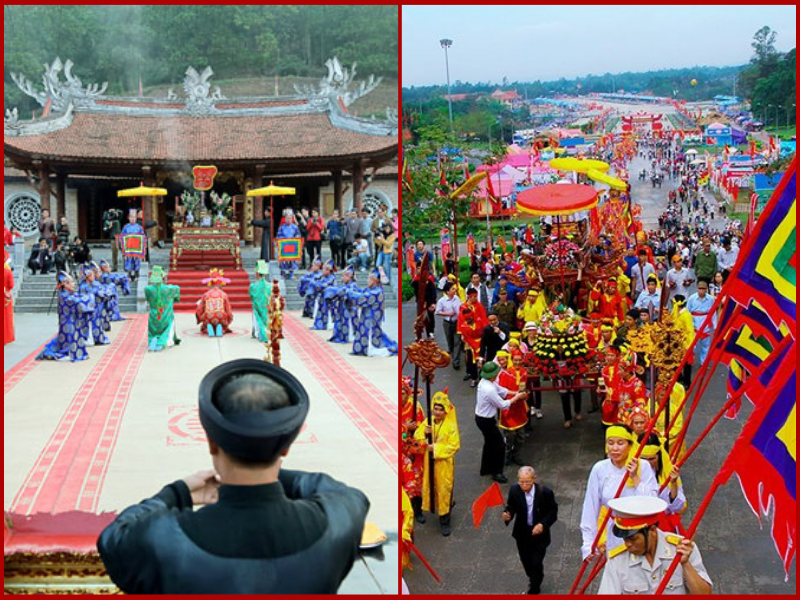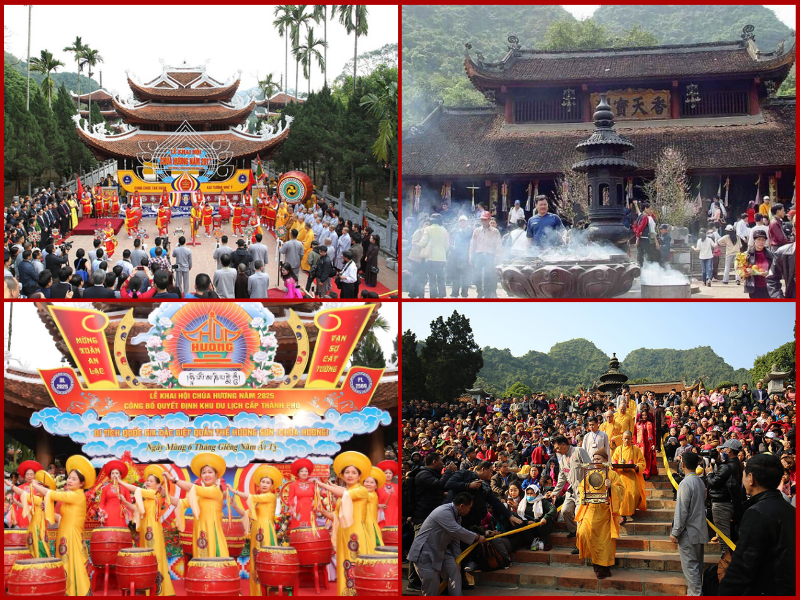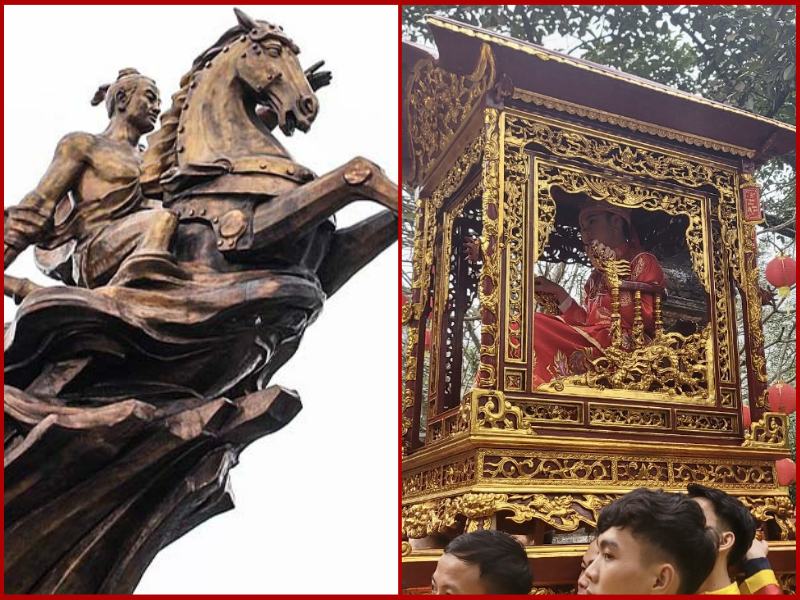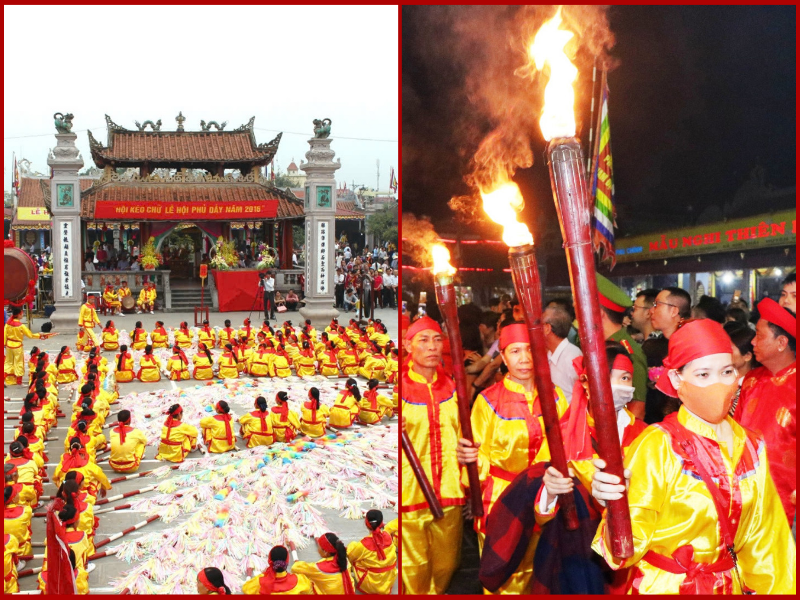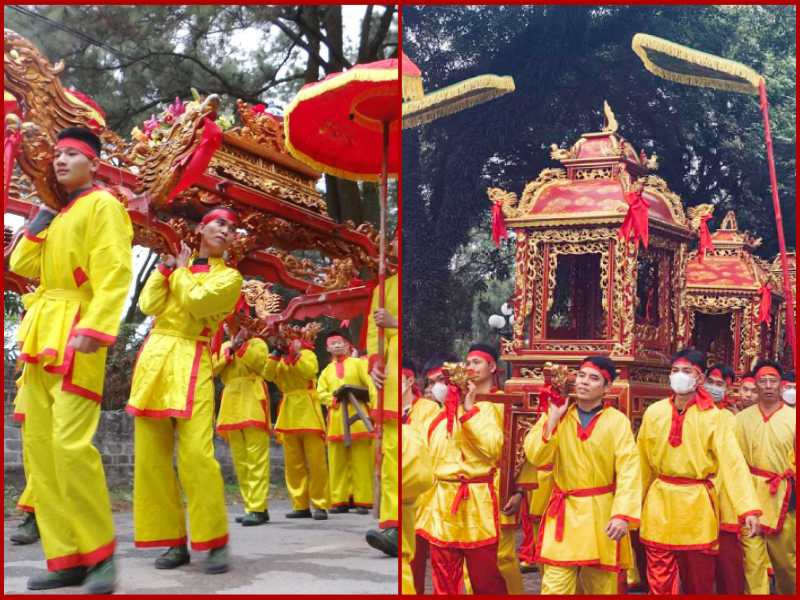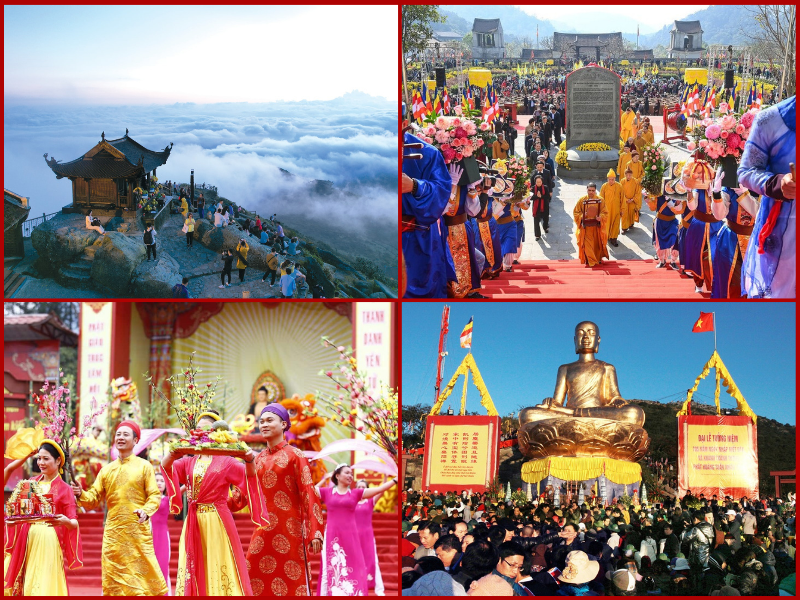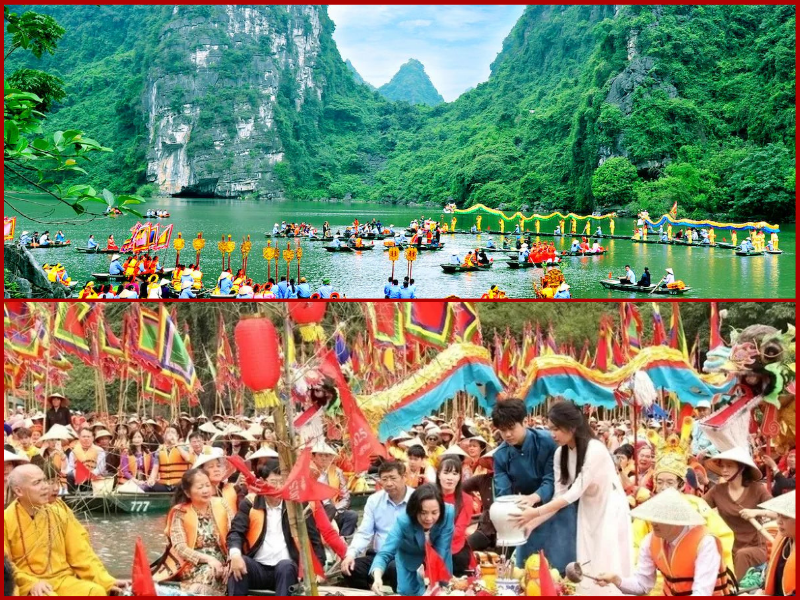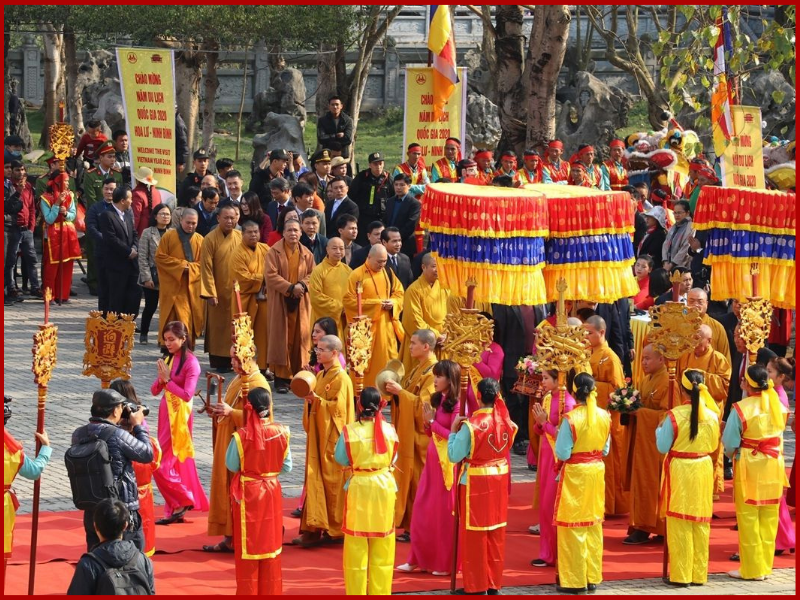Spring is the most festive season in Vietnam, especially in the northern region where countless cultural and spiritual celebrations take place. Participating in Vietnam Customized Tours from January to April (lunar calendar), tourists will see villages, temples, and pagodas come alive with processions, rituals, folk games, and traditional performances. For travelers, joining these spring festivals is not only about witnessing local traditions but also experiencing the unique harmony of faith, history, and community spirit in Vietnamese culture.
Every festival in Vietnam contains 2 parts: The Ritual and the Festival. The Ritual is always the most important part for worshipping, honoring, offering, and reporting everything that happened in the last year, what was achieved, and what remained to the ancestors in heaven. The Festival is the part in which visitors can fully enjoy the traditional games and explore Vietnamese culture.
Below are the top 7 traditional spring festivals in Northern Vietnam that you should not miss on your journey to Vietnam in Vietnam Tailor Made Tours with
Nadova Tours.
1. Hùng Kings' Festival – Phú Thọ
1.1. The beginning days
The history of the beginning of the nation is when Fairy Mother Âu Cơ and Dragon Father Lạc Long Quân gave birth to one hundred kids. They said, after realizing Fairy and Dragon don't have lifestyles in common, Mother and Father decided to separate: Fairy Mother goes up to the mountains with 50 kids, and Dragon Father goes down to the seas with the remains. The oldest son who goes up to the mountains with Fairy Mother becomes Hùng King the First. They rule the country with 18 successive Hùng Kings and become Vietnamese’s sacred ancestors.
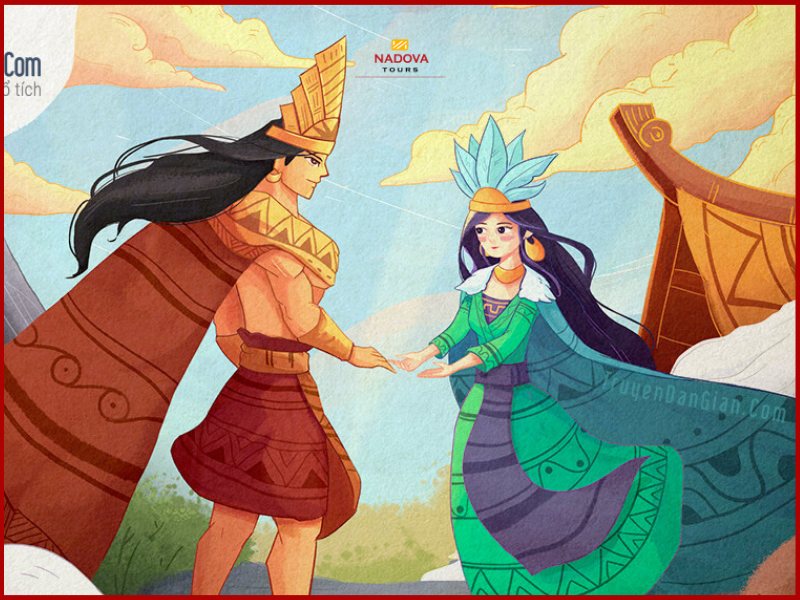
1.2. Hùng Kings’ Festival – The Day of Remembrance
The Hùng Kings Festival, or Giỗ Tổ Hùng Vương, is one of Vietnam’s most important national celebrations, held annually on the 10th day of the third lunisolar month in Phú Thọ Province. Dedicated to the Hùng Kings—the legendary founders of the Vietnamese nation—the festival is both a solemn commemoration and a vibrant cultural event.
On this day, all people across the country have a day off. This is the official holiday in Vietnam.
1.3. Things to do in Hùng Kings’ Festival
During the festival, thousands of locals from across the country gather at the Hùng Temple Complex to offer incense, participate in processions, and pay tribute to their ancestors. Alongside the ceremonies, visitors can enjoy folk games, traditional music, and regional specialties, creating a lively atmosphere that blends spirituality with community joy.
Recognized by UNESCO as an Intangible Cultural Heritage of Humanity, the Hùng Kings Festival reflects the Vietnamese people’s deep respect for their roots and national identity. For travelers, it is a unique opportunity to witness a living tradition that connects past and present.
2. Hương Pagoda Festival – Hà Nội
Every year, as spring arrives, white plum blossoms bloom across the mountains and forests of Hương Sơn, millions of Buddhists gather to offer prayers, and visitors from all directions eagerly arrive at the Hương Pagoda Festival, embarking on a journey to a Buddhist land. In the place where the Bodhisattva Avalokiteshvara practiced good deeds and cultivated the path, people dedicate a stick of incense, a prayer, or to let their soul soar and blend with nature in a region still bearing the marks of Buddhist stories and spiritual culture.
The Hương Pagoda Festival is the largest and longest festival in Vietnam, starting from the 6th day of the first lunisolar month and lasting until the last week of the third lunisolar month. The first day of the festival was originally the day the pagoda opened the forest, and the local people later made it the opening day of the festival. Thousands of pilgrims travel along the Yến Stream by boat, surrounded by breathtaking limestone mountains and blossoming forests, before hiking up to the sacred Hương Tích Pagoda.
The festival is both a spiritual journey and a scenic adventure. Visitors pray for peace, prosperity, and good fortune while enjoying the peaceful beauty of the countryside. For international travelers, it is one of the best opportunities to immerse in Vietnam’s Buddhist culture.
3. Gióng Festival – Hà Nội
One of Four Immortals – four chief figures in the pantheon of genii worshiped by the Vietnamese people of the Red River Delta region in legend and mythology, Saint Gióng is a legendary hero who defended the country against foreign invaders.
According to legend, Sóc Sơn district in the foot of Sóc Sơn mountain is the final place Saint Gióng stops by after completely defeating the enemy and defending the country, he takes a rest there and sees the country one last time before ascending to heaven. Therefore, on every 6th day of the first lunisolar month, the villagers here are holding a grand festival at the Sóc Temple Historical Site, which worships Saint Gióng – the Heavenly King Phù Đổng. The Gióng Sóc Sơn Festival takes place over three days with all the traditional rituals, such as the opening ceremony, the procession, the offering of incense and bamboo flowers to the Thượng Temple, where Saint Gióng is worshiped.
Recognized by UNESCO as an Intangible Cultural Heritage of Humanity, the Gióng Festival reflects the Vietnamese people’s strong patriotism and respect for national heroes.
4. Phủ Dầy Festival – Nam Định
4.1. Mother Goddess' Commemoration
March is considered "Mother Goddess' Commemoration Month" – a time to commemorate the anniversary ascending to heaven of Mother Goddess Liễu Hạnh, a powerful matriarchal deity revered by the people as a symbol of the desire for freedom, filial piety, patriotism, and compassion. Along the winding paths between the lush green rice fields of Kim Thái commune, visitors from all over can find over 20 different historical sites. Each point is associated with legends about the Mother's merit, from the place of "descent to earth" to the place of "ascension to heaven," forming a diverse system of relics such as the Tiên Hương Main Palace, Vân Cát Palace, and Liễu Lord's Tomb. The gathering of these spiritual architectures contributes to honoring Nam Định as one of the country's major religious centers. What's special is that the Phủ Dầy Festival has both religious significance and reflects the rich folk cultural life of the rice-growing agricultural residents in the Red River Delta region.
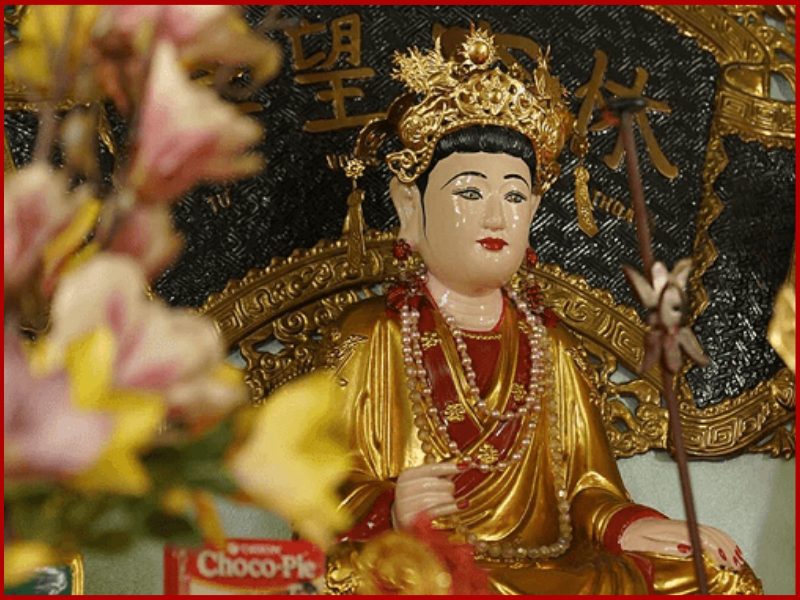
4.2. Phủ Dầy Festival – When is held and what to do
Held in the third lunisolar month in Nam Định province, the Phủ Dầy Festival celebrates Mother Goddess Liễu Hạnh, a revered figure in Vietnamese spiritual belief. The festival includes vibrant processions, lion and dragon dances, traditional music, and particularly the Hầu đồng (spirit possession ritual), which is central to the Mother Goddess worship practice.
The festival is a colorful and spiritual event that combines solemn rituals with vibrant folk culture. Visitors can witness incense offering ceremonies, palankeen processions, chầu văn singing, and lên đồng (spirit possession rituals)—all of which reflect the richness of Đạo Mẫu practice.
Alongside the spiritual activities, the Phủ Dầy Festival also features folk games, traditional performances, and bustling markets, making it both a sacred pilgrimage and a lively cultural celebration.
For travelers, attending the Phủ Dầy Festival offers a unique opportunity to explore Vietnam’s indigenous beliefs, admire traditional music and ritual arts, and experience the deep cultural heritage of the Red River Delta.
5. Côn Sơn – Kiếp Bạc Festival – Hải Dương
5.1. Spring Festival
The Cultural and Historical Relic Site Côn Sơn – Kiếp Bạc is known as a center of cultural and historical significance in Vietnam. Every year, in springs, the traditional Côn Sơn – Kiếp Bạc Festival will be held from 14 to 23 in the first lunisolar month, which speciality with the Ceremony of the Festival at 16th first lunisolar month, the Offering Ritual on Mount Ngũ Nhạc, the Memorial Ceremony for Venerable Huyền Quang, the Third Patriarch of Trúc Lâm Zen.
5.2. Autumn Festival
In autumn, there is the Autumn Festival Côn Sơn – Kiếp Bạc organized from 10th to 20th of the eighth month of the Vietnamese lunisolar calendar, usually in September or October. This festival has 3 mains ritual: Commemoration of the Anniversary of the Passing of National Hero and World Cultural Figure Nguyễn Trãi; Seal Opening and Bestowal Ceremony and Commemoration of the Anniversary of the Passing of National Hero Trần Quốc Tuấn (Hưng Đạo Đại Vương).
The Festival part in Côn Sơn – Kiếp Bạc Festival features exciting folk games and competitions such as Bánh Chưng Wrapping and Bánh Giầy Pounding Contest; Earth Firecracker game, Traditional Wrestling Competition, Human Traditional Chess Tournament, etc.
6. Yên Tử Festival – Quảng Ninh
Every spring, the Yên Tử Spring Festival in Quảng Ninh Province attracts thousands of pilgrims and travelers seeking both spiritual fulfillment and cultural discovery. Known as the cradle of Vietnamese Buddhism, Yên Tử Mountain is home to ancient pagodas, scenic landscapes, and solemn rituals that honor centuries-old traditions.
Beyond spiritual rituals, the Yên Tử Festival presents a vibrant cultural space. Traditional music, folk games, artistic performances, and regional cuisine enrich the atmosphere, allowing visitors to immerse themselves in both the sacred essence and festive joy of Vietnamese culture.
6.1. Opening ceremony
The festival officially begins on the 10th day of the first month in the Vietnamese lunisolar calendar. The opening ceremony is conducted with great solemnity, featuring ritual drum beating, ceremonial bell ringing, and incense offering, all performed to pray for peace, prosperity, and national well-being.
6.2. Highlights
One of the most impressive highlights is the palankeen procession, where monks, nuns, Buddhist followers, and local residents join together in a dignified march, carrying the palankeen from Trình Pagoda to Hoa Yên Pagoda. This ritual not only reflects Buddhist devotion but also symbolizes community unity.
For visitors, the most memorable part of the festival is the pilgrimage up Yên Tử Mountain. Travelers can either hike along one thousand stone paths shaded by ancient forests or take the modern cable car system. Along the way, pagodas and temples offer peaceful stops for prayer, with the sacred Đồng Pagoda at the summit serving as the ultimate destination and spiritual highlight.
The journey symbolizes spiritual enlightenment, and the panoramic view from the top is a reward in itself. For nature lovers, the Yên Tử Festival offers both cultural depth and breathtaking scenery.
7. Tràng An Festival – Ninh Bình
7.1. Tràng An Festival – Commemoration ancestors and worship Mother nature
Tràng An - a place associated with the great historical milestones of Vietnam with several events in each dynasty, from the time of Emperor Đinh Tiên Hoàng, who continued the national lineage of the Hùng Kings to protect independence and unify the country, Emperor Lê's resistance against the Song Dynasty and the Chiêm Kingdom, Emperor Trần Thái Tông's establishment of Vũ Lâm Imperial Palace during the resistance against the Yuan-Mongol invasion, the lightning-fast advance of Emperor Quang Trung-Nguyễn Huệ toward Thăng Long, and the great defeat of the Qing army.
To express gratitude and remember the gods, ancient emperors, and ancestors who contributed to the construction and protection of the country, promoted national prosperity and peace, and ensured favorable weather, the Tràng An Festival is held annually at 18th of the third lunisolar month at the Tràng An Ecotourism Complex in Hoa Lư City, Ninh Bình Province.
7.2. Memorable activities in Tràng An Festival
The festival opens with solemn ceremonies, including incense offering, drum and bell rituals, and grand processions. Visitors can witness the Dragon procession, palankeen procession, and water procession on the poetic Sào Khê River, all of which symbolize reverence for the nation’s ancestors and the harmony between people and nature.
Beyond the rituals, the Tràng An Festival transforms the entire heritage site into a stage for immersive cultural performances. Hundreds of artists and performers from across Vietnam showcase traditional music, dance, and regional art forms in large-scale open-air shows that unfold against the stunning natural backdrop of limestone mountains, rivers, and caves.
For travelers, the Tràng An Festival offers more than a cultural spectacle—it is a journey into the soul of Vietnam. The event beautifully combines history, spirituality, and natural beauty, allowing visitors to honor the nation’s roots while exploring the breathtaking scenery of Ninh Bình.
Frequently Asked Questions about Vietnamese Festivals
1. When is the festival season in Vietnam?
Most major festivals take place in spring (January–April in the lunisolar calendar), especially around Tết Nguyên Đán (Lunar New Year). However, important events are also held throughout the year.
2. Do Vietnamese festivals follow the lunar calendar?
Vietnam uses the lunisolar calendar, not the purely lunar calendar. That’s why festival dates often change each year when converted to the solar calendar.
3. What are some of the most famous festivals in Vietnam?
Tết (Lunar New Year) – the biggest national holiday.
Hùng Kings Temple Festival (Phú Thọ) – honoring Vietnam’s legendary founders.
Yên Tử Festival (Quảng Ninh) – a Buddhist pilgrimage linked to King Trần Nhân Tông.
Tràng An Festival (Ninh Bình) – paying tribute to King Đinh Tiên Hoàng.
Mid-Autumn Festival – a family celebration with lanterns and mooncakes.
4. Can foreign visitors join Vietnamese festivals?
Yes! Many festivals are open to the public. Visitors can join processions, enjoy traditional games, watch cultural performances, and taste local food.
5. What should I keep in mind when attending a festival?
Dress respectfully, especially at temples and pagodas.
Ask before taking photos during solemn rituals.
Be mindful of crowds, as popular festivals attract thousands of participants.
6. Are festivals only about religion?
Not always. While many are rooted in spirituality or ancestor worship, festivals also feature folk games, cultural shows, music, dance, and local cuisine.
7. Which festival is best for first-time travelers?
If you visit in spring, the Hùng Kings Temple Festival or Tràng An Festival are highly recommended. For autumn travel, the Mid-Autumn Festival in Hanoi is a colorful, family-friendly celebration.
8. How far and how long is it from Hanoi to those festivals above?
Statistics calculated in normal condition and stable traffic, starting at the center of Hanoi.
Hùng Kings’ Festival: 90km, ~2 hours. 7km from Việt Trì city.
Hương Pagoda Festival: ~61km, ~1 hour 15 minutes.
Gióng Festival: 35km, ~1 hour.
Phủ Dầy Festival: 83km, ~1-2 hours. 14km from Nam Định city.
Côn Sơn - Kiếp Bạc Festival: 74km, ~2 hours. 33km from Hải Dương city.
Yên Tử Festival: 129km, ~3 hours. 45km from Hạ Long city.
Tràng An Festival: 97km, ~2 hours. 6km from Ninh Bình city.
Explore Vietnamese Traditional Festival with Nadova Tours
Spring festivals in Northern Vietnam are more than just cultural events—they are living traditions that connect communities, honor ancestors, and celebrate the new year. Whether you join a pilgrimage at the Hương Pagoda, witness the heroic Gióng Festival, or experience the sacred atmosphere of Yên Tử, each festival will bring you closer to the soul of Vietnam.
Plan your trip around these festivals with Nadova Tours to enjoy both Vietnam’s stunning landscapes and its most authentic cultural celebrations.


